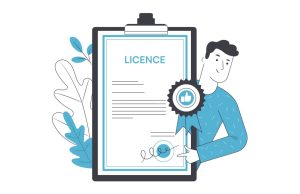When you’re starting an aesthetic business, getting your finances and accounting in order will be one of the first items on your to-do list.
Alongside understanding your tax obligations and your self-assessment requirements, you’ll also want to know about VAT.
You’ll want to know if and when you need to register for VAT, how to do it, and what that means for your business.
It might seem a little complicated at first glance, but this guide will walk you through how to register for VAT in eight simple and easy to understand steps.
If you’re looking for more help growing your aesthetic business, check out more guides, blogs and articles in our Aesthetic Business Hub.
Step 1: Understanding what VAT is
First, you need to be clear on exactly what Value Added Tax (VAT) is.
Put simply, it’s a sales tax on goods and services that’s usually included within the advertised price. We pay VAT on most items we buy on a daily basis.
The standard VAT rate is 20%.
Businesses that reach the VAT threshold have to charge VAT to their customers, and then pass on that VAT to HMRC.
Step 2: Do you need to register for VAT?
You need to register your aesthetics business for VAT if you reach the VAT threshold. Currently, that means if your turnover is more £85,000 in any 12-month period.
This doesn’t mean a financial year, it means any rolling 12-month period.
So if your aesthetics business expects to provide more than £85,000 worth of treatments (that are eligible for VAT tax – see VAT exemptions below) between October 1st and September 30th for example, you must register for VAT.
Step 3: Should you register for VAT?
When you’re just starting out, perhaps working part time initially, £85,000 can seem like a high figure that you won’t reach. One you don’t need to worry about it.
But if you’re working as an aesthetic practitioner and offering lucrative Botox and dermal filler treatments, you might reach that threshold sooner than you think. Planning ahead and registering early could save you a lot of time and hassle in the future.
Plus, there are other benefits you might want to consider. Registering for VAT:
- Makes your business look more professional and more established
- Helps you get organised with all your record keeping from day one
- Lets you claim money back on all your set-up purchases and supply costs
The downside to VAT registration is the administration. You have to keep good records and submit a VAT return every quarter… but your accountant can do this for you.
Step 4: Applying for your VAT number
The process to actually register for VAT and claim your business’ unique VAT number is simple.
You can register for VAT online.
Sign into your Government Gateway account (or create one if you don’t already have an account) and follow the step by step instructions.
You’ll just enter some essential information about your business.
You can register for VAT as either a sole trader or limited company. [link to sole trader v ltd company blog]
If you have an accountant, you can appoint them as your agent to submit your VAT returns on your behalf.
It’s important to note:
There are several different VAT schemes relevant to different industries or circumstances. It’s highly likely that as an aesthetics business these won’t apply to you, and you’ll be best off with standard VAT registration, but always speak to a tax and accounting professional to be sure.
Once completed, you’ll receive an “effective VAT registration date” along with your 9-digit VAT number.
Step 5: Charging VAT to your clients
After receiving your VAT number, you must add it to all your invoices and start charging your clients VAT for all VAT-applicable goods and services.
Your advertised prices should be inclusive of VAT.
You should:
- Work out the VAT inclusive price (most likely with standard 20% VAT)
- Show your VAT number on all invoices
- Save details of the VAT transaction
- Record the amount of VAT on your VAT return
To calculate a VAT inclusive price, simply multiply your current/non-VAT price by 1.2.
For example an £80 treatment becomes £96. (80×1.2 = 96)
Here’s where thinking about VAT when you start your aesthetics business comes in handy
If you price all your treatments and services as if you will be repaying 20% on everything from the outset, then even if you don’t register for VAT initially, you’ll know that you won’t need to change your pricing and charge your clients more when you do have to VAT register.
It means that when you’re not VAT registered, you’ll have extra profits. And any VAT you do have to pay back is covered and accounted for. It’s win win.
Aesthetics treatments: What’s VAT exempt and what isn’t?
The biggest challenge with VAT registration for aesthetics businesses comes with knowing what you should charge VAT for, and what’s exempt.
According to HMRC, “VAT exempt goods and services include: healthcare and medical treatment”
However, cosmetic treatments ARE subject to VAT at 20%.
Which leads to the question:
Which kinds of aesthetic treatments are classed as medical, which as cosmetic?
A VAT notice specifically aimed at health professionals clarifies what HMRC means by ‘health professionals’, referencing treatment provided by “medical professionals who are registered on the appropriate statutory register”.
That would cover nurses, dentists and pharmacists administering aesthetic treatments, right?
Not necessarily. It goes to on explain that any service performed by a health professional must meet the following condition:
“The primary purpose of the services is the protection, maintenance or restoration of the health of the person concerned.”
This is the grey area of medical vs cosmetic, and whether your treatments are VAT exempt or not. What’s the difference between treatments intended to improve and protect the health of a client, compared with those just for ‘cosmetic reasons’?
HMRC, despite referring to cosmetic services in its VAT notice, is unhelpful:
“Each case will need to be considered on its individual merits. However, we will generally accept that cosmetic services are exempt where they’re undertaken as an element of a health care treatment programme. Where services are undertaken purely for cosmetic reasons, they will be standard-rated.”
It basically amounts to “We’re not sure”. It’s too difficult for HMRC to give firm guidance, so you need to tread carefully.
- Treatments for acne, hyperhidrosis and other skin conditions are likely provided to ‘restore a person’s health’
- Botox and lip fillers to enhance a client’s beauty are not, so cosmetic injectables are charged at the standard VAT rate
You need to be confident your treatments are strictly medical, given for a medical purpose, if you want to treat them as VAT-exempt. You’ll need to maintain ‘patient records’ – including a medical history, consultation form, professional diagnosis sheet, and treatment plan. A diagnosis by a medical professional is the key piece of paperwork that HMRC would look at.
Software like Pabau can help you seamlessly record, collate and store all these essential client files, so there’s one less thing for you to think about.
Not sure which treatments might be tax exempt? Speak to an accountant and get expert advice. Of course, you might find the hassle of dealing with VAT-exempt and VAT-applicable treatments is not worth the money you might save on VAT repayments, in which case you could treat all your services as cosmetic ones.
Step 6: Reclaiming VAT on your purchases
When you charge VAT to your clients, you can also claim back any VAT you pay for your business expenses.
That means if you’ve been kitting out your clinic and buying desks, chairs, stationary, computers etc., you can claim back 20% of the price.
Any goods or services you claim VAT back on must have been purchased ‘for business use’. If you use items for personal use, you can claim a proportion of the VAT back.
For example, if you work from home, you can claim a proportion of VAT back on your utility bills. Speak to your accountant for more help and advice here.
If you’re working with medical supplies, then as per above, you may find that these purchases are VAT exempt, so you can’t claim the VAT back on them.
And if you’re selling both taxable and exempt services – i.e. medical and cosmetic treatments – your aesthetics business is considered partially exempt. That means there are restrictions on what you can reclaim.
Again, speak to an accountant for more details.
Step 7: Sending a VAT return (and paying any VAT owed)
Once you (or your accountant) have worked out how much VAT you owe to HMRC from your sales, and how much VAT you’re reclaiming from your purchases, you submit a VAT return.
You’ll usually send one every quarter (3 months), and the deadline to file and pay what you owe is one month and seven days after the accounting period.
i.e: If your VAT period is January to March, you have until May 7th.
You can check accounting and payment dates via your online account
You submit your VAT return:
- Automatically through accountancy software
- Via your accountant
Step 8: Keeping good VAT records
The most important thing to remember about VAT accounting is to keep good, digital records at all times.
You need to keep:
- All sales invoices and client receipts
- All purchase invoices
- Details of your suppliers
- A record of everything you buy and sell (whether it’s VAT exempt or not)
… for at least six years.
Of course this is all part of good business record keeping.
Software like Pabau can help you ditch the paperwork and keep secure digital files of important records that HMRC might want to see.
In fact, as part of their Making Tax Digital scheme, HMRC requires you to keep digital records of all VAT details.
Got any more questions on VAT for your aesthetics business?
Talk to your accountant to get specific tax and VAT advice relevant to your circumstances. They’ll be able to offer all the help and advice you need.
Looking for more information on setting up your business finances? Our Ultimate Guide to Starting Your Aesthetic Business has all the accounting information you need to start your practice, including details on corporation tax, self assessment and more. [link to ultimate guide landing page]
And if you want other advice on setting up or running your clinic, head over to our Aesthetic Business Library. [link to library hub page]




